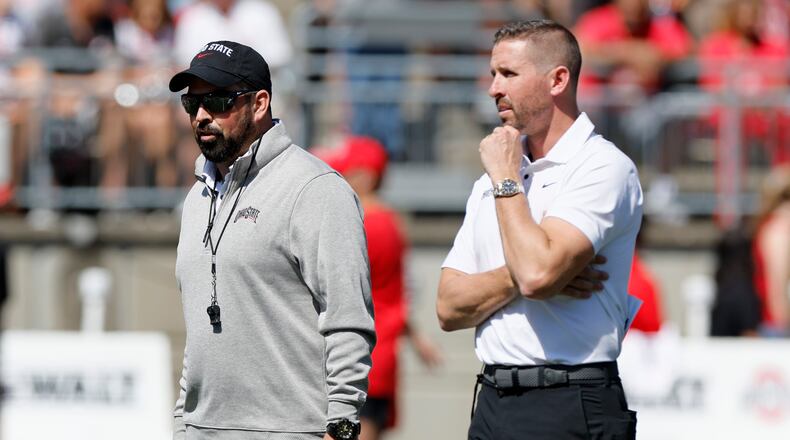For now let’s take a look at some of the potential pros and cons:
Brian Hartline promoted to offensive coordinator
Pros: Staff continuity, chance to develop a coordinator in-house and perhaps even set up a succession plan.
Safe to assume Ohio State will be a pass-first team this year even with a first-year starting quarterback. The Buckeyes still have the weapons (Jeremiah Smith, Carnell Tate, Brandon Inniss) on the outside to do it, and the offensive line will have big question marks, at least to start the year.
The ongoing attempt to make the running game a strength instead of a liability didn’t really work last season, but in the playoffs they proved again they can be a passing juggernaut when it’s time to put all the cards on the table.
Day winning the national championship shooed the wolves away from the door (at least until the Wolverines are back on the horizon come November), but I can’t help but think he won’t be a lifer at Ohio State. (He told Dan Patrick a couple of weeks ago he might consider the NFL after his kids are out of school, which would be in about 6-8 years), so the timing could work out for Hartline to be next in line in a few years if this move works out.
Tight ends coach Keenan Bailey reportedly is also receiving a promotion to co-offensive coordinator and new offensive line coach Tyler Bowen was the offensive coordinator at Virginia Tech the past three years, so they have an all-new mix of minds crafting the attack.
Credit: DaytonDailyNews
Cons: Potential leadership void, predictable running game put too much pressure on a young unit, leading to breakdowns in big games
How much the Buckeyes revert to what they were doing before Chip Kelly arrived year ago will be interesting to watch.
We still haven’t seen Day develop a dominant running attack at Ohio State outside of the first year, when he had a bunch of Urban Meyer’s players coming of age and a young Justin Fields (a Day acquisition) at quarterback.
There is no reason to think that changes until we see it, but will it be a good enough change-up to support the passing game?
The best thing Kelly did in his one season at Ohio State was lean more toward gap schemes over zone blocking, which helped a group that wasn’t physically overwhelming perform more effectively, especially in the playoffs.
Going back to trying to make outside zone work without physically dominating blockers could be a huge step back for the offense and make the job of a first-year quarterback much harder.
Matt Patricia hired as defensive coordinator
This would qualify as the opposite of hiring from within as Patricia hasn’t even been in college football for two decades.
Pros: Continuity in the secondary, extensive game-planning experience and flexibility utilizing different personnel
The departure of Jim Knowles to Penn State led to talk of needing to prioritize maintaining the stuff that worked last season, most notably setting up super sophomore safety Caleb Downs to make plays all over the field.
With secondary coach Tim Walton and Matt Guerrieri receiving new titles, it stands to reason the defensive backs will be deployed much the same way they were last season even if three starters are new.
Knowles was also known for crafting opponent-specific game plans. That is somewhat unique in college, but it was a hallmark of the Bill Belichick New England Patriots teams under which Patricia developed.
Cons: Will Patricia mesh with the current staff? Will his defense be too complicated? Was he just a product of the Belichick machine?
Belichick might be the greatest football coach of all time, but his tree hasn’t yielded much fruit despite all its branches. That includes Patricia being a flop as head coach of the Detroit Lions, so how much of the Patriots’ success (three Super Bowl victories) in Patricia’s time was a product of the head coach (not to mention the quarterback) is an open question.
Game planning also presents a fine line between doing enough to keep the offense guessing and avoiding paralysis by analysis, something we frequently see happen when NFL coaches come to college.
There’s also always a question of how a newcomer will mesh with the returning staff and the player culture that is in place.
Other notes this week:
º Spring football is set to begin March 17, about 2.5 weeks later than usual because of the extended playoff run. It will still end April 12 with a “spring showcase.” That may or may not involve a game. They will still have 15 days of practice, but those will be conducted over a shorter period of time rather than starting in early March then taking time off for spring break.
º CBS Sports came out with a report last week offering some context on Knowles’ decision to leave Ohio State for Penn State.
TL;DR: Knowles was never able to fully implement his scheme because of defensive line coach Larry Johnson’s love for four-man fronts, and his feathers were ruffled when Day started getting involved with defensive meetings after the unit got eviscerated by Oregon in October.
While the first part was an open secret for three years, the second item makes Day look a lot better than Knowles.
I understand egos are a thing, but the bottom line is the first 2.5 years of the Knowles experience in Columbus were underwhelming, and the last 10 games were great. If it took Day getting involved to get the coaches on the same page to create an effective defense with 11 or 12 future NFL players on it, then Day took another step toward becoming a great head coach. If that hurt Knowles’ feelings so much he had to leave town despite being one year into a lucrative contract, well… maybe that’s for the best.
About the Author

